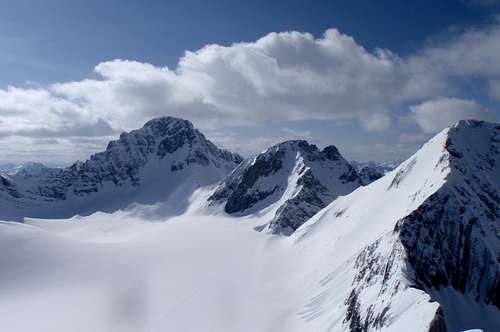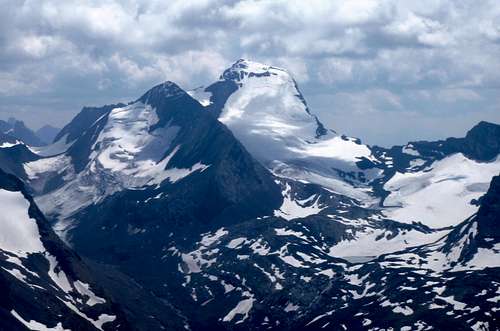-
 8022 Hits
8022 Hits
-
 75.81% Score
75.81% Score
-
 6 Votes
6 Votes
|
|
List |
|---|---|
|
|
The summits along this section of the divide, and the adjacent connecting peaks, were named after World War I to commemorate the British and French military forces. Generally, from Mt. Nivelle north to Mt. Cordonnier are French military names and included in the Joffre Group of mountains; from Mt. Warrior north to Mt. Turbulent are British military names and included mostly in the Spray Range, but a few northern summits are in the Goat Range.
The Haig Glacier was named after Sir Douglas Haig. Sir Haig commanded the British Forces during the much of World War I (1915-1919) and was the successor of Field Marshall John Denton Pinkstone French. Mt. Sir Douglas was named for Sir Haig. Mt. French for John French who commanded the British Forces during the first sixteen months of World War I. Mt. Robertson is named for Field Marshal Sir William Robert Robertson who was a British Army officer who served as Chief of the Imperial General Staff from 1916 to 1918. Mt. Monro for Major General Sir Charles Carmichael Monro who briefly commanded the British First Army in France before becoming Commander-in-Chief India later that year. Mt. Jellicoe for Sir John R. Jellicoe, a commander of the British Grand Fleet from 1914 to 1916. Mt. Maude for Major General Sir Frederick Stanley Maude, a British commander who captured Baghdad during WW I.
The Mangin Glacier (wholly in Alberta) and the adjoining glaciers of Petain, Castelnau, Elk and Nivelle (these four glaciers are wholly in British Columbia) provide the largest, near continuous, sheet of glacier ice in the Kananaskis area, but the Haig Glacier is the most extensive singularly named glacier in K-country. Portions of the Haig Glacier do extend into British Columbia, but the majority of the glacier is within Alberta and Peter Lougheed Provincial Park.
Adjacent, or near, to the extensive Haig Glacier are three smaller glaciers, Robertson, French and Smith-Dorrien. The Robertson and French Glaciers provide the nearest access to the Haig Glacier. Considering the proximity of Calgary, and the growing human population surrounding Kananaskis, the valleys and trails surrounding the Haig still maintain an air of wilderness and isolation. The surrounding landscape provides a healthy population of all native species, including Grizzly and Black Bears, Cougar, Lynx, Moose, Elk and many smaller mammals, fish, flora and fauna. Be aware of potential wildlife conflicts and act accordingly in the backcountry.
Six significant summits encircle the Haig Glacier, providing a high wall to trap and contain moisture, and hopefully, slow the melt of this grand glacier.

|
Mount Sir Douglas
3406 metres (11,174 ft.) The king of the Haig Glaicer. Second highest summit in Kananaskis and one of the only two 11,000'ers in K-country. Beautiful peak with an interesting variety of challenging climbing routes. |
.

|
Mount French
3234 metres (10,611 ft.) Second highest summit along the Haig Glacier. This peak has significant glaciers on three sides, with only the northern fringes free of ice. A substantial northern outlier reaches 3185 metres and can provide an interesting additional highpoint on a traverse. |
.

|
Mount Robertson
3194 metres (10,480 ft.) A sharp and pointy summit block with narrow summit ridges and striking outliers. Presents an eye-catching profile to the Robertson Glacier. Difficult summit to attain including a modern and demanding alpine rock route. |
.

|
Mount Jellicoe
3085 metres (10,121 ft.) Diversity in the structure of this mountain provides several severely steep faces (all unclimbed), along with mellow south slopes. The southern slopes and ridge provides an excellent ski mountaineering objective in a remote setting. |
.

|
Mount Maude
3042 metres (9,981 ft.) The lowest elevation summit adjacent to the Haig Glacier, but this peak is not easy to attain. The couloir on the North-East Face provides an excellent moderate alpine climb and a very courageous ski descent. |
.





